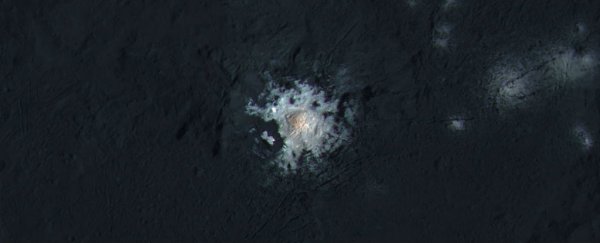Last year, Ceres - a dwarf planet that sits between Mars and Jupiter - was the subject of intense debate as researchers all over the world tried to figure out what formed the planet's mysterious white spots. Though that mystery is now pretty much solved, NASA's Dawn spacecraft just sent back some of the clearest pictures of these bright spots ever taken.
The new pictures, which were unveiled at the 47th annual Lunar and Planetary Science Conference in Texas, were taken from a distance of 385 kilometres (240 miles) above the Occator Crater, a hole on the dwarf planet's surface that stretches 92 kilometres across and 4 kilometres deep (57 x 2 miles).
These new photos provide an unprecedented look inside the crater and its extremely bright centre. As planetary scientist Ralf Jaumann explains:
"Before Dawn began its intensive observations of Ceres last year, Occator Crater looked to be one large bright area. Now, with the latest close views, we can see complex features that provide new mysteries to investigate. The intricate geometry of the crater interior suggests geologic activity in the recent past, but we will need to complete detailed geologic mapping of the crater in order to test hypotheses for its formation."
Besides the crater photos, the team has also released a colour map of Ceres' surface that highlights what materials the dwarf planet's made of and how craters are distributed around it. This data will help researchers understand what lies blow the Ceres' surface.
 NASA/JPL-Caltech/UCLA/MPS/DLR/IDA/PSI
NASA/JPL-Caltech/UCLA/MPS/DLR/IDA/PSI
They also revealed that water has been found in the Oxo Crater by the visible and infrared mapping spectrometer (VIR), which is always big news. It turns out that Ceres is full of little mysteries other than its well-known, bright salt patches.
The new data will enable researchers to further understand how Ceres formed, how much water is hidden there and, of course, more information on its weird regions like Occator Crater.
As Jamie Condliffe explains at Gizmodo, while astronomers are now confident that the bright spots on the Occator Crater are made from salt, it recently came to light that they seem to be constantly changing, and no one's quite sure how or why.
"We're excited to unveil these beautiful new images, especially Occator, which illustrate the complexity of the processes shaping Ceres' surface," said Carol Raymond, deputy principal investigator for the mission. "Now that we can see Ceres' enigmatic bright spots, surface minerals, and morphology in high resolution, we're busy working to figure out what processes shaped this unique dwarf planet."
You can view more of the newly released pictures here.
